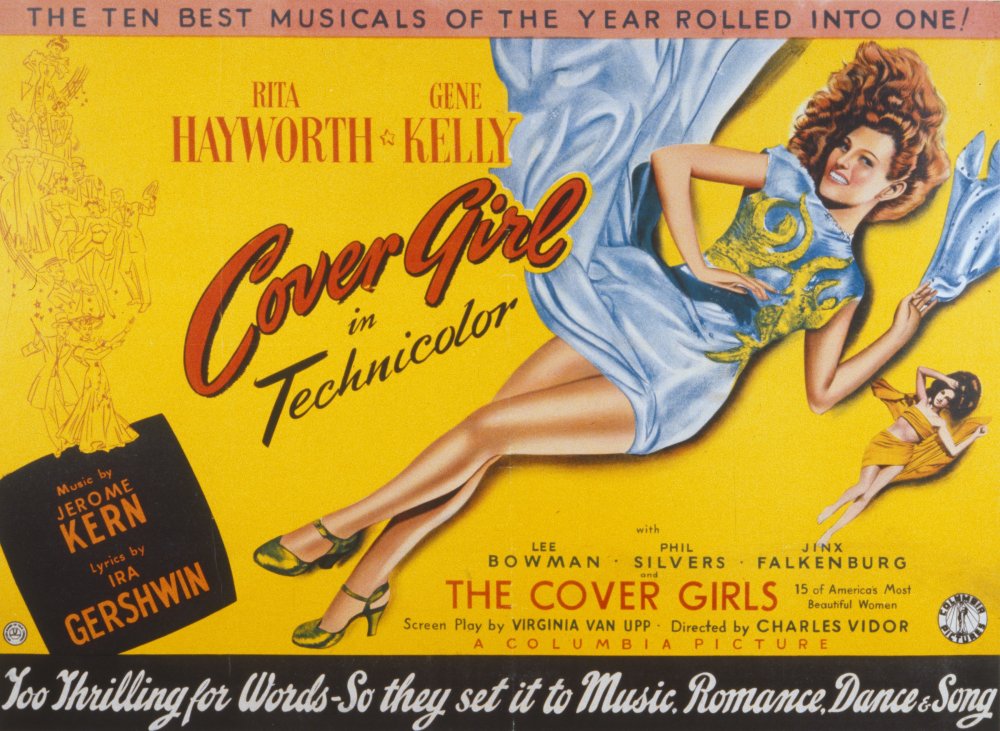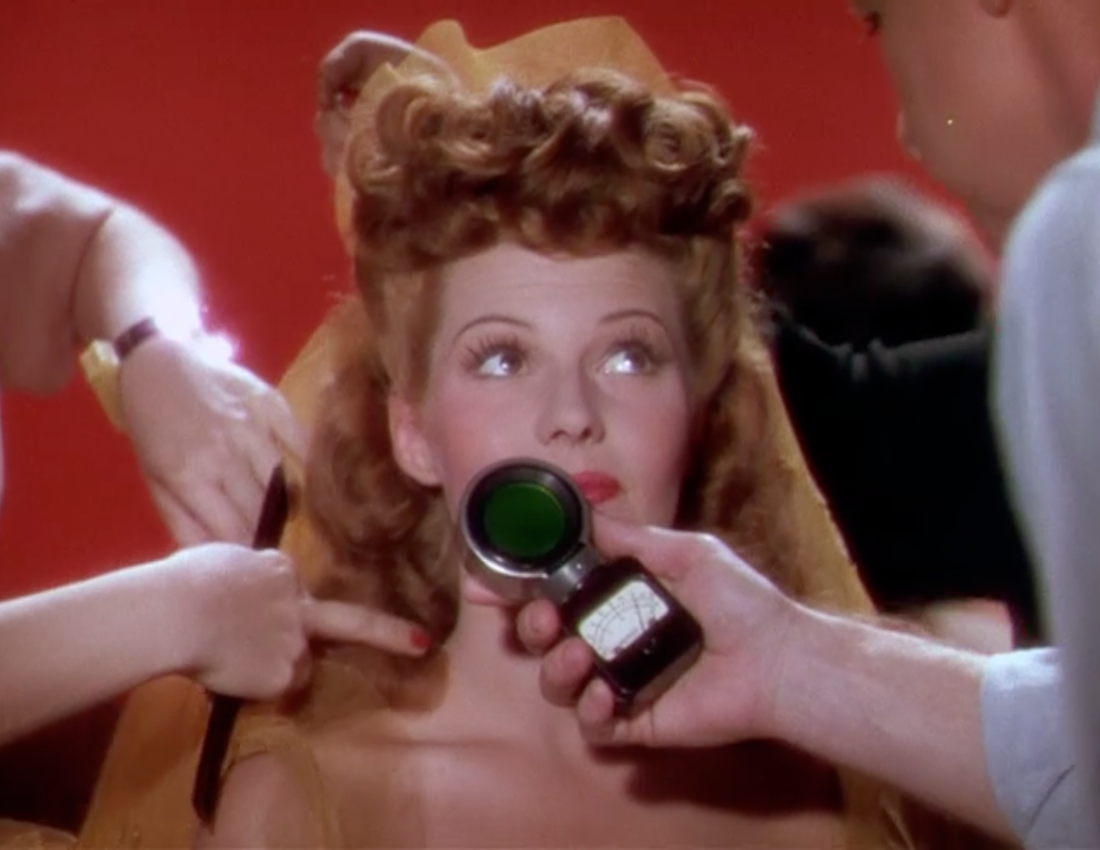
I’m an unabashed Gene Kelly fan. The 1952 classic Singin’ in The Rain is my favorite musical and I’ve given up counting how many times I’ve seen it. Ditto 1949’s On the Town, 1951’s An American in Paris, and 1945’s Anchors Aweigh, for which Kelly earned his only Oscar nomination for Best Actor.
And I’ve always had a soft spot in my heart for Columbia’s endearing 1944 Technicolor musical comedy Cover Girl, which changed the careers of Kelly and his leading lady Rita Hayworth. It’s fun, frothy, and extremely romantic, especially when Kelly and Hayworth (dubbed by Martha Mears) sing the haunting ballad “Long Ago and Far Away.”
Kelly also demonstrated his genius as a dancer and choreographer in the energetic “Make Way for Tomorrow” and the "Alter Ego” number, in which he dances with his inner self.
Penned by Virginia Van Upp, Cover Girl revolves around a beautiful singer/dancer Rusty Parker (Hayworth), who works in a nightclub in Brooklyn owned and operated by her boyfriend Danny (Kelly). When Rusty gets a chance to become a cover girl magazine model, it causes a rift between her and Danny.
For the World War II- era audiences, Cover Girl was a breath of fresh air. Featuring a lovely score by Ira Gershwin and Jerome Kern, unbeatable chemistry between Kelly and Hayworth, and terrifically fun supporting performances from Eve Arden and Phil Silvers, Cover Girl was one of the biggest hits of the year and won the Oscar for scoring.

I recently chatted via email with author Patricia Ward Kelly, the star’s widow, and Grover Crisp, Sony Pictures Entertainment’s EVP Asset Management, Film Restoration & Digital Mastering, about the importance of the film to the studio, as well as Kelly and Hayworth’s careers and the intricacies of the new digital restoration of the 3-strip Technicolor film.
Q: What did Cover Girl mean to Columbia?
Grover Crisp: It was the first Columbia Pictures musical to be shot in the 3-strip Technicolor process. Though she was costarring in a number of films, including two musicals with Fred Astaire for Columbia, Cover Girl clearly boosted Rita Hayworth’s profile as a Hollywood star. I think it was the first time she got top billing in a picture. Her leading lady status was cemented with her next two releases, Tonight and Every Night, and especially Gilda.
Cover Girl was one of the top box office successes of the year. So the film definitely has its place in the Columbia pantheon.
Q: Patricia, Gene was under contract to MGM and had appeared in such musicals as 1942’s For Me and My Gal and 1943’s Thousands Cheer. How did he get loaned out to Columbia for Cover Girl?
Patricia Ward Kelly: The picture had already started without a leading man. The head of the studio, Harry Cohn, did not want Gene in the role. It was the producer, composer Arthur Schwartz, who really pushed to get Gene in the movie. Eventually, Cohn came around and became quite supportive of Gene and his choreography, making "Make Way for Tomorrow" and the "Alter Ego” numbers possible by breaking out the stage walls.
The "Alter Ego" number is so revolutionary. It was the first time anyone had ever dollyed and panned in double exposure with Technicolor. Everyone said it could not be done, but Gene knew it was possible if he connected the camera movement to musical beats. It was very ahead of its time and exceptionally difficult.
Q: What did Cover Girl mean to Columbia?
Grover Crisp: It was the first Columbia Pictures musical to be shot in the 3-strip Technicolor process. Though she was costarring in a number of films, including two musicals with Fred Astaire for Columbia, Cover Girl clearly boosted Rita Hayworth’s profile as a Hollywood star. I think it was the first time she got top billing in a picture. Her leading lady status was cemented with her next two releases, Tonight and Every Night, and especially Gilda.
Cover Girl was one of the top box office successes of the year. So the film definitely has its place in the Columbia pantheon.
Q: Patricia, Gene was under contract to MGM and had appeared in such musicals as 1942’s For Me and My Gal and 1943’s Thousands Cheer. How did he get loaned out to Columbia for Cover Girl?
Patricia Ward Kelly: The picture had already started without a leading man. The head of the studio, Harry Cohn, did not want Gene in the role. It was the producer, composer Arthur Schwartz, who really pushed to get Gene in the movie. Eventually, Cohn came around and became quite supportive of Gene and his choreography, making "Make Way for Tomorrow" and the "Alter Ego” numbers possible by breaking out the stage walls.
The "Alter Ego" number is so revolutionary. It was the first time anyone had ever dollyed and panned in double exposure with Technicolor. Everyone said it could not be done, but Gene knew it was possible if he connected the camera movement to musical beats. It was very ahead of its time and exceptionally difficult.

From that point forward, he was determined to "lick" that thing he called the "one-eyed monster" - the camera - and he set out to change the look of dance on film.
Question: I guess his stock at MGM rose after Cover Girl.
Patricia Ward Kelly: MGM finally sat up and took notice (they also made a considerable profit on loaning Gene out). As Gene said to me, "after Cover Girl, I got important to MGM."
Question: He found the perfect dance partner in Hayworth.
Patricia Ward Kelly: Gene loved Rita. He said she was a "great dame." He felt she had a wonderful fluidity in her movement. He and Phil Silvers had a lot of fun with her on this on and off the set.
Question: Grover, has this film been restored before now?
Grover Crisp: There was some preservation work done in the mid-1990’s, mainly to have a good safety copy of the nitrate original negatives, but, this was the first time we really approached the film with the idea of restoring it with the technologies available today.

Question: So the original negatives still exist?
Gordon Crisp: Yes, the original 3-strip nitrate negatives were borrowed from the Columbia Pictures collection housed at the Library of Congress.
Question: Where there any major issues with the negatives?
Grover Crisp: There were the usual issues with film elements from this period - vertical scratches, torn frames, and a lot of dirt embedded in the negatives. And of course, there are three complete negatives, so a lot more work needed to be put into this than usual film with only one negative. Color breathing (sometimes called flicker) in the Technicolor negatives is always a challenge to repair and virtually impossible in earlier periods, but there are digital algorithms that have been developed to help alleviate the problem. It is still present, but much reduced.
Question: Will this newly restored Cover Girl be heading to Blu-ray soon?
Grover Crisp: Cover Girl was released on Blu-ray a few years ago from an HD video made from a safety master positive. The transfer itself is fine, but not as representative of the kind of work we do now. We hope to make a 4K Ultra HD version of the film available in the future so more fans can see the latest restoration.
Cover Girl will play on the big screen at the Egyptian Theatre on Saturday, May 21 at 3:30 PM, following a 2:00 PM illustrated presentation about the emotional struggle to save Radio City Music Hall from demolition in the 1970s. Author Rosie Novilleno-Mearns will speak about her part in working to save the building where she danced. Following the talk, she will sign her book Saving Radio City Music Hall: A Dancer’s True Story. The event is a co-presentation of the American Cinematheque at the Egyptian Theatre and the Art Deco Society of Los Angeles.
Gordon Crisp: Yes, the original 3-strip nitrate negatives were borrowed from the Columbia Pictures collection housed at the Library of Congress.
Question: Where there any major issues with the negatives?
Grover Crisp: There were the usual issues with film elements from this period - vertical scratches, torn frames, and a lot of dirt embedded in the negatives. And of course, there are three complete negatives, so a lot more work needed to be put into this than usual film with only one negative. Color breathing (sometimes called flicker) in the Technicolor negatives is always a challenge to repair and virtually impossible in earlier periods, but there are digital algorithms that have been developed to help alleviate the problem. It is still present, but much reduced.
Question: Will this newly restored Cover Girl be heading to Blu-ray soon?
Grover Crisp: Cover Girl was released on Blu-ray a few years ago from an HD video made from a safety master positive. The transfer itself is fine, but not as representative of the kind of work we do now. We hope to make a 4K Ultra HD version of the film available in the future so more fans can see the latest restoration.
Cover Girl will play on the big screen at the Egyptian Theatre on Saturday, May 21 at 3:30 PM, following a 2:00 PM illustrated presentation about the emotional struggle to save Radio City Music Hall from demolition in the 1970s. Author Rosie Novilleno-Mearns will speak about her part in working to save the building where she danced. Following the talk, she will sign her book Saving Radio City Music Hall: A Dancer’s True Story. The event is a co-presentation of the American Cinematheque at the Egyptian Theatre and the Art Deco Society of Los Angeles.
- by Susan King
Veteran journalist Susan King wrote about entertainment at the Los Angeles Times for 26 years (January 1990 - March 2016), specializing in Classic Hollywood stories. She also wrote about independent, foreign and studio movies and occasionally TV and theater stories. She received her master's degree in film history and criticism at USC. After working 10 years at the L.A. Herald Examiner, she moved to the Los Angeles Times.
Follow her on Twitter: @mymackie
